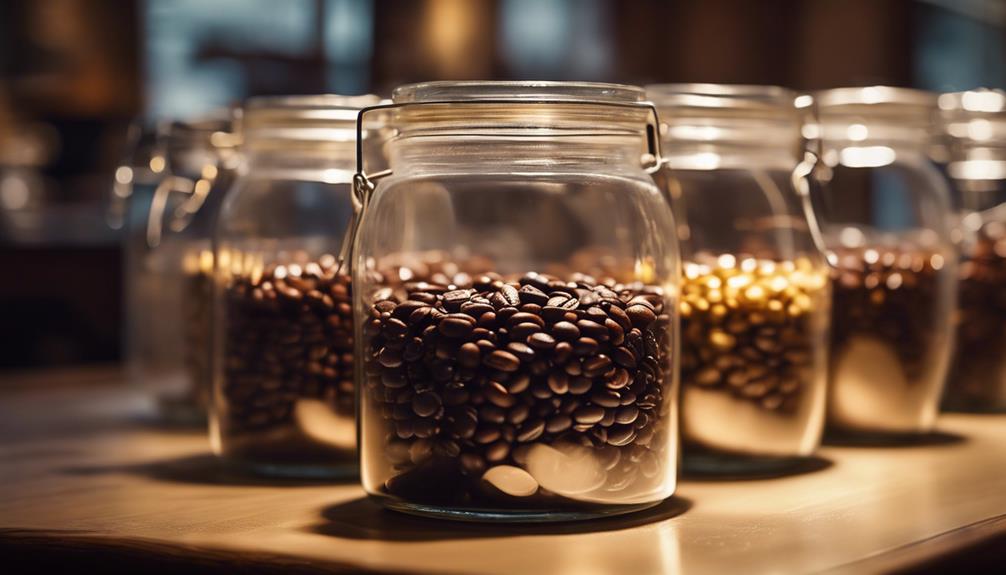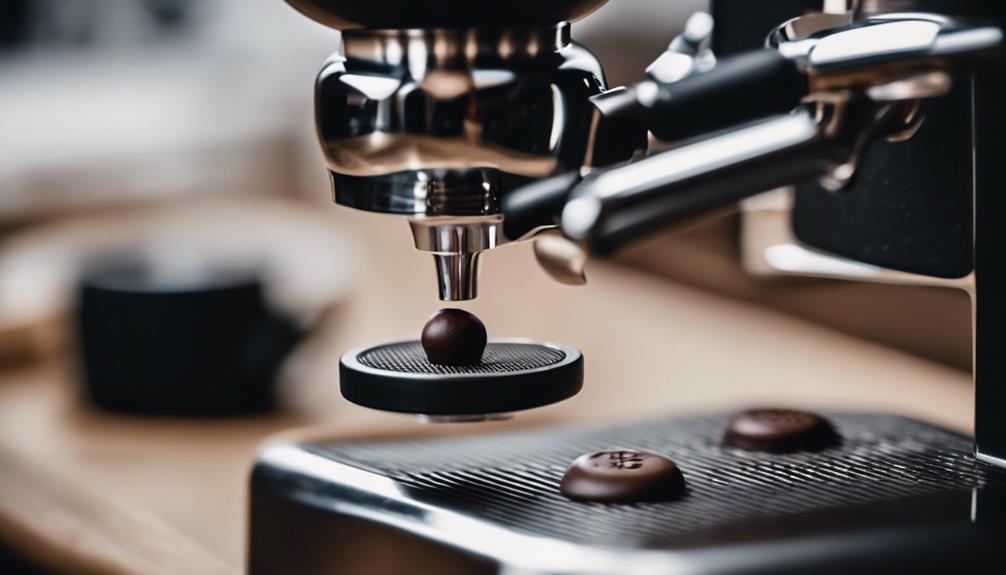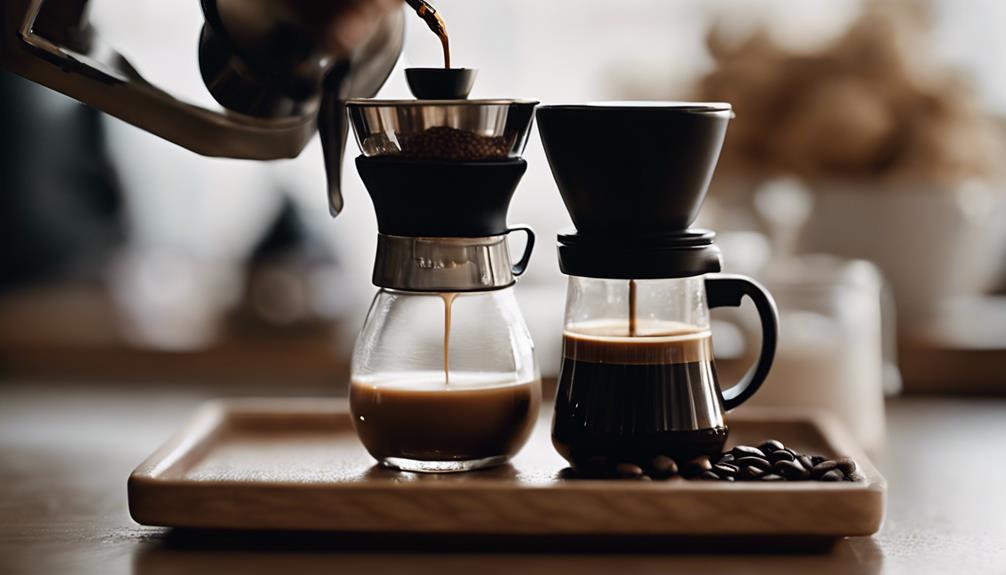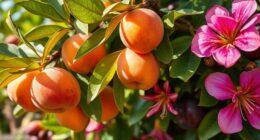You are on the verge of mastering the art of brewing espresso like a professional, and it all begins with selecting the perfect beans. When choosing the finest espresso beans, take into consideration the roast level, origin, and freshness. Dark roasts result in bold, bitter flavors, while medium roasts provide sweetness and complexity. Arabica beans are renowned for their rich, smooth flavor, while Robusta beans contribute body and crema. Try experimenting with single-origin and blended options to discover your personalized flavor profile. With numerous factors impacting the ideal cup, you are just one step away from brewing like a skilled barista – and there is even more to look forward to.
Key Takeaways
- Freshness matters: Use beans within 5 days to 2 weeks of the roast date for optimal flavor and aroma.
- Roast level preference impacts flavor, with darker roasts producing heavier, bitter flavors and medium roasts offering sweetness and complexity.
- Single-origin beans showcase unique tasting notes specific to the origin, while blends provide a balanced flavor by combining beans from different origins.
- Popular espresso brands include Herkimer Coffee Espresso Blend, Lavazza Super Crema, and Stumptown Hair Bender, each offering distinct flavor profiles.
Understanding Espresso Beans
When it comes to espresso, you're not limited to specific beans, as any coffee can be used. However, traditional preferences often lean towards dark roasts, while medium roasts are gaining popularity for their complex and sweet flavors.
It's crucial to take into account the freshness of your espresso beans, as this greatly impacts the flavor profile. Look for beans that are freshly roasted, ideally within 5 days to 2 weeks of the roast date. This guarantees you get the best tasting notes from your coffee.
As you explore different espresso blends, you'll notice that most are 100% Arabica, which is renowned for its distinct flavor profile. Some blends may include Robusta for added body and crema, but Arabica remains the preferred choice.
When selecting coffee blends, reflect on the origin of the beans, as single-origin beans offer unique flavor profiles. By understanding these factors, you'll be able to choose the perfect espresso beans for your taste preferences, whether you prefer a medium roast or a rich, dark roast.
Factors Influencing Bean Selection
When selecting the perfect espresso beans, you need to contemplate what matters most to you.
Do you prefer a specific roast level that brings out the flavors you love?
Are you particular about the origin of your beans, or do you prioritize freshness above all else?
Roast Level Preference
How do you take your espresso – bold and rich or smooth and sweet? Your roast level preference greatly impacts the flavor of your espresso.
Dark roasts are a popular choice for their bold, chocolatey flavors, while medium roasts offer a sweeter and more complex profile. But it's not just about the roast level – your personal taste plays an essential role in bean selection. Do you prefer the smoothness of medium roasts or the richness of dark roasts?
The roasting process enhances flavor complexity, with lighter roasts highlighting fruity or floral notes and darker roasts developing deeper caramelized flavors. Freshness is vital, regardless of roast level, so be sure to check roast dates when selecting beans.
Experimentation with different roast levels is key to discovering your unique flavor preferences. Each roast can deliver distinct tasting notes and an overall coffee experience. By trying out different roast levels, you'll be able to identify the flavor profile that suits your taste buds the best.
Bean Origin Impact
You'll find that the origin of your espresso beans plays a crucial role in shaping the flavor profile of your perfect cup, with different regions imparting unique characteristics that can make or break your espresso experience.
The bean origin impact on flavor complexity is significant, with regions like Ethiopia offering bright and fruity notes, while Brazilian beans are known for their chocolate and nut flavors. Coffee sourced from Central America, such as Guatemala and Honduras, often provides a balanced profile with sweet and mild characteristics, making them popular choices for espresso blends.
As a coffee enthusiast, you'll discover that the altitude at which coffee is grown also impacts its flavor, with higher elevations typically producing beans with greater acidity and more intricate flavor profiles.
Specialty coffee shops often highlight single-origin beans that showcase distinct regional flavors, allowing you to explore varied taste experiences based on origin.
Freshness Matters
As you explore the world of espresso, you're likely to discover that freshness plays an essential role in releasing the full flavor potential of your carefully selected beans.
Freshly roasted beans are essential for peak flavor, and it's recommended to use them within 5 days to 2 weeks post-roast. When sourcing beans, look for the roast date instead of relying on 'best before' dates, as this guarantees you're getting the freshest possible beans.
It's also vital to store your beans properly in airtight canisters to preserve their freshness. Whole beans are the way to go, as they retain their flavor better than pre-ground coffee.
Grind your beans just before brewing to maximize freshness, and experiment with different grind sizes to find the perfect fit for your brew method.
Roast Levels and Their Impact

Flavor nuances unfold when you explore the world of roast levels, where the perfect balance can make or break the taste of your espresso. As you investigate the world of espresso roast coffee, you'll discover that roast levels considerably impact the overall taste and quality.
Here are three key things to keep in mind:
- Dark roasts vs medium roasts: Traditional Italian espresso often favors dark roasts, which produce heavier, more bitter flavors. Medium roasts, on the other hand, offer sweeter and more complex profiles.
- Caramelizing sugars: The roasting process caramelizes sugars in the coffee, similar to cooking onions, and requires careful balancing to avoid burning.
- Personal preferences: Experimenting with different roast levels can lead to discovering your personal preferences for espresso. Darker roasts work well with milk-based espresso drinks, while medium and light roasts offer unique flavor profiles, including bright, fruity, or floral notes, when brewed correctly.
Single Origin Vs Blends
When selecting the perfect espresso beans, the decision between single-origin and blended options can greatly impact the flavor profile you're looking for.
As a coffee enthusiast, you might want to explore single-origin espresso, which showcases unique tasting notes specific to the coffee's origin. For instance, Ethiopian coffees are known for their bright, fruity notes.
On the other hand, blends combine beans from different origins to achieve a balanced flavor, making them a great choice for espresso shots. Blends are crafted to provide complexity and sweetness, appealing to a wider range of palates.
The trend towards single-origin espresso is growing in specialty coffee circles, reflecting a consumer interest in exploring unique flavors and supporting specific coffee-growing regions.
Many roasters experiment with both single-origin and blended options, allowing you to taste the difference and find your preferred espresso experience.
Whether you prefer the distinct flavor profiles of single-origin espresso or the balanced taste of blends, there's an option out there for you.
Coffee Bean Types: Arabica Vs Robusta
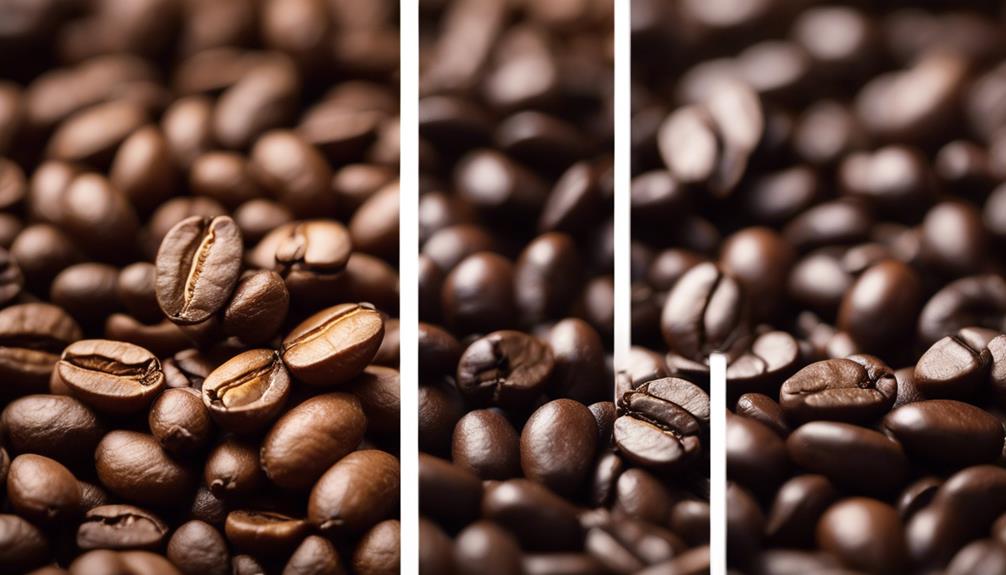
When you're searching for the perfect espresso beans, you'll likely come across Arabica and Robusta options.
You might wonder what sets these two types apart, and it all comes down to flavor profile and caffeine content.
You'll want to evaluate whether you prefer Arabica's nuanced, complex flavors or Robusta's bold, energizing boost.
Arabica's Flavor Profile
As you explore the world of specialty coffee and espresso, you'll likely find that Arabica beans are the go-to choice for their rich, smooth flavor profile that's bursting with notes of sweetness, fruit, and acidity. This complexity is what sets Arabica apart from other coffee beans, making it a favorite among coffee connoisseurs.
The nuanced flavors of Arabica beans are due to the specific growing conditions they require, which contribute to their higher prices.
Here are three reasons why Arabica beans stand out:
- Sweet and fruity notes: Arabica beans are known for their sweet, fruity flavors, which add depth and character to your espresso.
- Balanced acidity: The acidity in Arabica beans is balanced, providing a smooth and revitalizing taste experience.
- Smooth mouthfeel: The lower caffeine content in Arabica beans results in a smoother, less bitter taste, making them perfect for specialty coffee and espresso blends.
Robusta's Caffeine Boost
You're likely familiar with Arabica's smooth flavor profile, but Robusta beans offer a distinct advantage: a significant caffeine boost that can elevate your espresso experience.
With approximately 2.2-2.7% caffeine content, Robusta beans pack a punch that Arabica's 1.2-1.5% can't match. This higher caffeine content doesn't just give you an energy boost; it also enhances the crema in your espresso blends.
Robusta's flavor profile is distinct from Arabica's, with earthy and nutty notes that add a unique dimension to your espresso. While Arabica's fruity and floral notes are unmistakable, Robusta's bold flavor can hold its own in specialty blends.
In fact, specialty Robusta options are gaining popularity for their quality and unique tasting experiences. By incorporating Robusta into your espresso blends, you can create a rich, bold flavor that complements Arabica's smoothness.
Freshness and Storage of Coffee Beans
Opting for freshly roasted espresso beans is crucial for revealing the ideal flavor, and it's important to use them within a few weeks post-roast for the best taste experience. You want to guarantee you're getting the most out of your beans, and that means paying attention to the roast date, not just the 'best before' date.
Here are some tips to help you enjoy your freshly roasted coffee beans:
- Store them properly: Use airtight canisters to prevent exposure to air, moisture, light, and heat, which can quickly degrade the flavor.
- Let them rest: Allow your whole beans a resting period of 5 days to 2 weeks after roasting to develop their full flavor.
- Freeze them wisely: If you need to store your beans for a longer period, freezing can help prevent staleness, but be careful to avoid moisture exposure and condensation.
Brewing Techniques for Espresso
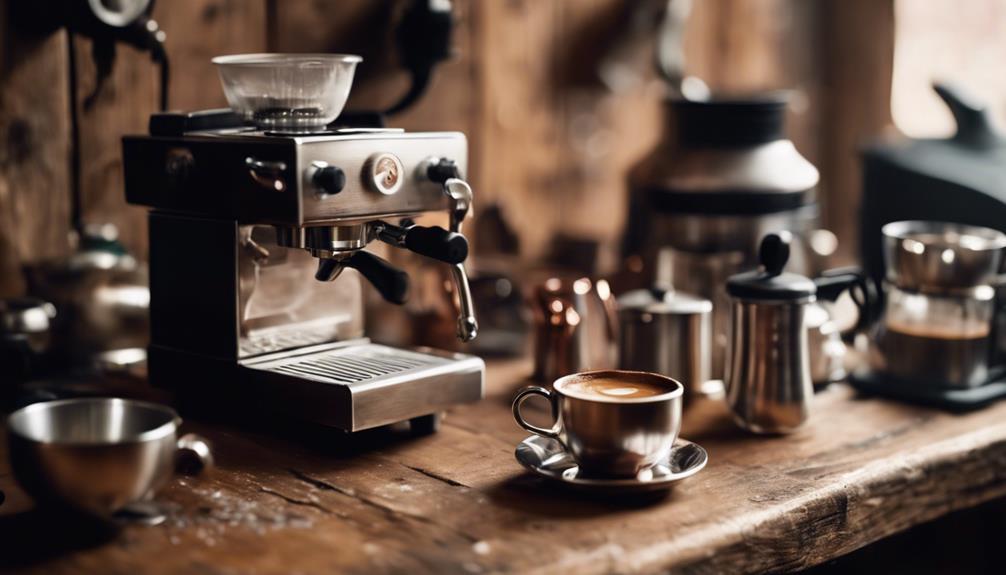
Now that you've secured the freshest possible espresso beans, it's time to focus on revealing their full potential through expert brewing techniques. To truly bring out the rich flavors and aromas of the espresso beans, consider investing in a high-quality ninja espresso machine. This advanced machine offers precise temperature control and pressure settings, allowing you to extract the perfect shot of espresso every time. With the right brewing techniques and the ninja espresso machine, you’ll be able to enjoy a consistently delicious cup of espresso that showcases the quality of your freshly roasted beans.
To get the most out of your espresso machines, you need to pay attention to the grind size, brewing time, and extraction speed. Experiment with different grind sizes to achieve the perfect espresso strength, ensuring an even grind for consistent extraction during the brewing process.
Aim for a brewing time of 25 to 30 seconds for a standard espresso shot, adjusting grind size and tamping pressure to control the extraction speed. Remember to use freshly ground coffee, ideally within 2-3 weeks of roasting, to maximize flavor and aroma in your espresso shots. This will help you disclose the unique flavor profiles of your coffee beans.
Regularly clean your espresso machine and equipment to prevent residue buildup, which can negatively impact the taste of your espresso. By following these brewing techniques, you'll be able to brew espresso shots that rival those of a coffee company with quality control.
Popular Espresso Bean Brands
With a world of flavors at your fingertips, it's time to explore the top-rated espresso bean brands that'll elevate your daily cup. You're no longer limited to the same old generic beans. Specialty coffee roasters have raised the bar, offering unique flavor profiles that'll take your espresso drinks to the next level.
Here are three popular espresso bean brands you need to try:
- Herkimer Coffee Espresso Blend: Rich chocolate notes and balanced flavor make this a favorite among espresso enthusiasts.
- Lavazza Super Crema: Creamy texture and a mild flavor profile, featuring notes of honey and almonds, ideal for milk-based drinks.
- Stumptown Hair Bender: A versatile blend of coffees from Latin America, Africa, and Indonesia, delivering a sweet, chocolatey, and citrusy flavor profile.
These brands offer a range of flavors, from rich and chocolatey to fruity and floral. Whether you're a fan of milk-based drinks or prefer a straight shot, there's a popular espresso bean brand out there for you.
Experiment with different roasters and flavor profiles to find your perfect cup.
Espresso Experimentation and Tasting

Experimenting with different espresso beans is a journey of discovery, revealing a wide range of flavor profiles and unique tasting notes that will enrich your overall espresso experience.
As you explore espresso experimentation, you'll find that tasting single-origin and blended options helps you understand how bean origin and blend composition impact the complexity and body of the shot.
To fully appreciate these flavor nuances, make sure to use freshly roasted beans, allowing them to rest for 5 days to 2 weeks post-roast for ideal taste.
Consistency in your brewing technique, including grind size and tamping pressure, is also vital for extracting the best flavors from each shot.
As you experiment, keep a tasting journal to track your flavor experiences and preferences. This will help you identify which blends or origins you enjoy most, guiding your future bean selections.
Frequently Asked Questions
Which Coffee Bean Is Best for Espresso?
You're wondering which coffee bean is best for espresso? The truth is, any coffee can work, but you'll want a blend that's balanced, sweet, and full-bodied. Dark roasts are classic, but medium roasts are gaining popularity for their complexity.
What Kind of Beans Do You Use in an Espresso Maker?
When you're brewing espresso, you'll want to use high-quality Arabica beans, preferably freshly roasted and finely ground, to achieve a rich and balanced flavor. You can opt for a single-origin or blended bean for your espresso maker.
What Beans to Use With Breville Barista Express?
When it comes to pairing beans with your Breville Barista Express, you'll want to opt for freshly roasted, whole beans with a medium to dark roast for a balanced sweetness and rich body.
What Is the Best Brand of Espresso?
When choosing the best brand of espresso, you'll want to contemplate your flavor preferences and brewing habits. Do you like creamy, balanced, or rich flavors? Look for brands that offer a range of profiles to suit your taste buds.
Conclusion
You've now got the keys to reveal the perfect shot!
With this knowledge, you're ready to commence on a flavorful journey, experimenting with top-rated espresso beans like a master chef seasoning their signature dish.
Remember, the world of espresso is a canvas, and you're the artist – every bean, a brushstroke of flavor, every brew, a masterpiece waiting to happen.
